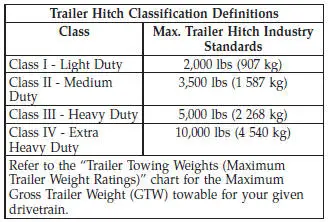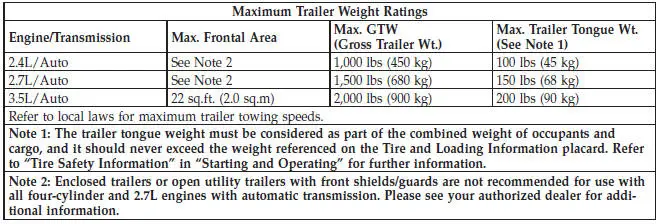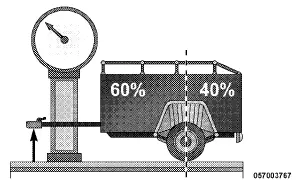Dodge Avenger: Trailer towing
 Dodge Avenger: Trailer towing
Dodge Avenger: Trailer towing
In this section, you will find safety tips and informationon limits to the type of towing you can reasonably dowith your vehicle. Before towing a trailer, carefullyreview this information to tow your load as efficientlyand safely as possible.
To maintain warranty coverage, follow the requirementsand recommendations in this manual concerning vehiclesused for trailer towing.
If you have any questions or concerns after reviewingthis section, please consult your dealer to for full detailson the towing capabilities of the vehicle.
Common Towing Definitions
The following trailer towing related definitions will assistyou in understanding the following information:
Gross Vehicle Weight Rating (GVWR)
The GVWR is the total allowable weight of your vehicle.
This includes driver, passengers, cargo, and tongueweight. The total load must be limited so that you do notexceed the GVWR. Refer to “Vehicle Loading/VehicleCertification Label” in “Starting and Operating” forfurther information.
Gross Trailer Weight (GTW)
The GTW is the weight of the trailer plus the weight of allcargo, consumables and equipment (permanent or temporary)loaded in or on the trailer in its loaded andready for operation condition.
The recommended way to measure GTW is to put yourfully loaded trailer on a vehicle scale. The entire weightof the trailer must be supported by the scale.
Gross Combination Weight Rating (GCWR)
The GCWR is the total permissible weight of your vehicleand trailer when weighed in combination.
NOTE: The GCWR rating includes a 150 lbs (68 kg)allowance for the presence of a driver.
Gross Axle Weight Rating (GAWR)
The GAWR is the maximum capacity of the front and rearaxles. Distribute the load over the front and rear axlesevenly. Make sure that you do not exceed either front orrear GAWR. Refer to “Vehicle Loading/Vehicle CertificationLabel” in “Starting and Operating” for furtherinformation.
WARNING:
It is important that you do not exceed the maximumfront or rear GAWR. A dangerous driving conditioncan result if either rating is exceeded. You could losecontrol of the vehicle and have an accident.
Trailer Tongue Weight (TW)
The tongue weight is the downward force exerted on thehitch ball by the trailer. In most cases it should not be lessthan or more than 10% of the trailer load. You mustconsider this as part of the load on your vehicle.
Frontal Area
The frontal area is the maximum height multiplied by themaximum width of the front of a trailer.
Weight-Carrying Hitch
A weight-carrying hitch supports the trailer tongueweight, just as if it were luggage located at a hitch ball orsome other connecting point of the truck. These kinds ofhitches are the most popular on the market today andthey are commonly used to tow small- and mediumsizedtrailers.
Trailer Hitch Classification
The following chart provides the industry standard forthe maximum trailer weight a given trailer hitch class cantow and should be used to assist you in selecting thecorrect trailer hitch for your intended towing condition.
Refer to the Trailer Towing Weights (Maximum TrailerWeight Ratings) chart for the Max. GTW towable for yourgiven drivetrain.

All trailer hitches should be professionally installed onyour vehicle.
Trailer Towing Weights (Maximum Trailer Weight Ratings)
The following chart provides the maximum trailer weight ratings towable for your given drivetrain.

CAUTION:
Towing a trailer with a larger than recommendedfrontal area could cause the engine to overheat orcause severe engine damage under extreme conditions.
Trailer and Tongue Weight
Always load a trailer with 60% to 65% of the weight inthe front of the trailer. This places 10% of the Gross TrailerWeight (GTW) on the tow hitch of your vehicle. Loadsbalanced over the wheels or heavier in the rear can causethe trailer to sway severely side to side which will causeloss of control of vehicle and trailer. Failure to loadtrailers heavier in front is the cause of many traileraccidents.
Never exceed the maximum trailer tongue weightstamped on your bumper or trailer hitch.

Consider the following items when computing theweight on the rear axle of the vehicle:
• The trailer tongue weight of the trailer.
• The weight of any other type of cargo or equipmentput in or on your vehicle.
• The weight of the driver and all passengers.
NOTE: Remember that everything put into or on thetrailer adds to the load on your vehicle. Also, additionalfactory-installed options, or authorized dealer-installedoptions, must be considered as part of the total load onyour vehicle. Refer to “Tire Safety Information/Tire andLoading Information Placard” in “Starting and Operating”for the maximum combined weight of occupantsand cargo for your vehicle.
CAUTION:
Incorrect trailer tongue weight could result in increasedyaw or vehicle instability. A negative trailertongue weight could unload the rear suspension ofthe tow vehicle decreasing vehicle stability. Negativetrailer tongue weight could cause the trailer to squatand potentially become disengaged from the towvehicle resulting in a runaway trailer condition.
Towing Requirements
To promote proper break-in of your new vehicle drivetraincomponents the following guidelines are recommended:
CAUTION:
• Do not tow a trailer at all during the first 500 miles(805 km) the new vehicle is driven. The engine,axle or other parts could be damaged.
• Then, during the first 500 miles (805 km) that atrailer is towed, do not drive over 50 mph(80 km/h) and do not make starts at full throttle.
This helps the engine and other parts of thevehicle wear in at the heavier loads.
WARNING:
Improper towing can lead to an injury accident.
Follow these guidelines to make your trailer towingas safe as possible:
• Make certain that the load is secured in the trailerand that it will not shift during travel. Whentrailering cargo that is not fully secured, dynamicload shifts can occur that may be difficult for thedriver to control. You could lose control of yourvehicle and have an accident.
• When hauling cargo, or towing a trailer, do notoverload your vehicle or trailer. Overloading cancause a loss of control, poor performance, or damageto brakes, axle, engine, transmission, steering,suspension, chassis structure, or tires.
• Safety chains must always be used between yourvehicle and trailer. Always connect the chains tothe frame or hook retainers of the vehicle hitch.
Cross the chains under the trailer tongue andallow enough slack for turning corners.
• Vehicles with trailers should not be parked on agrade. When parking, apply the parking brake onthe tow vehicle. Put the tow vehicle automatictransmission in PARK. Always, block or chockthe trailer wheels.
• GCWR must not be exceeded.
• Total weight must be distributed between the towvehicle and the trailer such that the following fourratings are not exceeded:
1. GVWR.
2. GTW.
3. GAWR.
4. Trailer tongue weight rating for the trailer hitchutilized (This requirement may limit the ability toalways achieve 10% of trailer tongue weight as apercentage of total trailer weight).
Towing Requirements – Tires
• Do not attempt to tow a trailer while using a compactspare tire.
• Proper tire inflation pressures are essential to the safeand satisfactory operation of your vehicle. Refer to“Tires – General Information” in “Starting and Operating”for proper tire inflation procedures.
• Check the trailer tires for proper tire inflation pressuresbefore trailer usage.
• Check for signs of tire wear or visible tire damagebefore towing a trailer. Refer to “Tires – GeneralInformation” in “Starting and Operating” for informationon tread wear indicators and for proper inspectionprocedure.
• When replacing tires, refer to “Tires – General Information”in “Starting and Operating” for informationon replacement tires and for proper tire replacementprocedures. Replacing tires with a higher load carryingcapacity will not increase the vehicle’s GVWR andGAWR limits.
Towing Requirements – Trailer Brakes
• Do not interconnect the hydraulic brake system orvacuum system of your vehicle with that of the trailer.
This could cause inadequate braking and possiblepersonal injury.
• An electronically actuated trailer brake controller isrequired when towing a trailer with electronicallyactuated brakes. When towing a trailer equipped witha hydraulic surge actuated brake system, an electronicbrake controller is not required.
• Trailer brakes are recommended for trailers over1,000 lbs (450 kg) and required for trailers in excess of2,000 lbs (907 kg).
CAUTION:
If the trailer weighs more than 1,000 lbs (450 kg)loaded, it should have its own brakes with adequatebraking capacity. Failure to do this could lead toaccelerated brake lining wear, higher brake pedaleffort, and longer stopping distances.
WARNING:
• Do not connect trailer brakes to your vehicle’shydraulic brake lines. It can overload your brakesystem and cause it to fail. You might not havebrakes when you need them and could have anaccident.
• Towing any trailer will increase your stoppingdistance. When towing, you should allow for additionalspace between your vehicle and the vehiclein front of you. Failure to do so could resultin an accident.
Towing Requirements – Trailer Lights and Wiring
Whenever you pull a trailer, regardless of the trailer size,stop lights and turn signals on the trailer are required formotoring safety.
Towing Tips
Before setting out on a trip, practice turning, stopping,and backing the trailer in an area located away fromheavy traffic.
Make sure all trailer and vehicle lights are workingproperly — including hazard flashers.
Automatic Transmission
The DRIVE range can be selected when towing. However,if frequent shifting occurs while in this range, thirdgear for a four-speed automatic and the fifth gear for asix-speed AutoStick should be selected.
NOTE: Using third or fifth instead of DRIVE whileoperating the vehicle under heavy operating conditions,will improve performance and extend transmission lifeby reducing excessive shifting and heat build-up. Thisaction will also provide better engine braking.
If you REGULARLY TOW a trailer for more than 45 minutesof continuous operation, then change the automatictransmission fluid and filter according to the intervalspecified for “police, taxi, fleet, or frequent trailer towing.”Refer to “Maintenance Schedule” for the propermaintenance intervals.
NOTE: Check the four-speed automatic transmissionfluid level before towing. The AutoStick six-speed transmissionis sealed and the fluid level cannot be checked.
See your authorized dealership service center forassistance.
Electronic Speed Control – If Equipped
• Do not use in hilly terrain or with heavy loads.
• When using the speed control, if you experience speeddrops greater than 10 mph (16 km/h), disengage untilyou can get back to cruising speed.
• Use speed control in flat terrain and with light loads tomaximize fuel efficiency.
Cooling System
To reduce potential for engine and transmission overheating,take the following actions:
• City Driving.
When stopped for short periods of time, shift the transmissioninto NEUTRAL and increase engine idle speed.
• Highway Driving.
Reduce speed.
• Air Conditioning.
Turn off temporarily.


